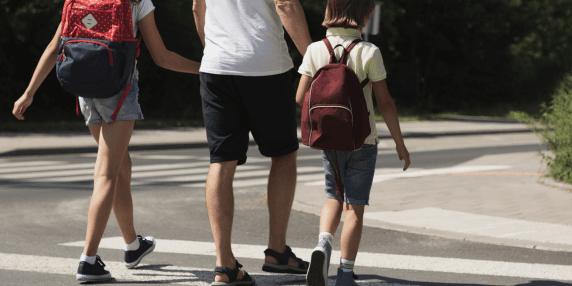Newsroom
ICBC sharing safety tips as children head back to school
August 28, 2023

As children return to school soon, we're sharing important tips for drivers, parents and caregivers to help children get a safe start to the school year.
As children return to school soon, we're sharing important tips for drivers, parents and caregivers to help children get a safe start to the school year.
Every month in B.C., 30 children are injured in crashes while walking or riding their bike.* Police and Speed Watch volunteers will be closely monitoring drivers' speeds in school zones.
We're working to make roads safer near schools. We've invested $1,250,000 in 101 projects focused on school safety since 2016. Last year alone, we completed 27 projects. Upgrades include adding pedestrian signals to crosswalks, rapid rectangular flashing beacons, raised medians, pedestrian refuge islands, speed reader boards and speed humps.
ICBC's tips for drivers:
Every school day, unless otherwise posted, a 30 km/h speed limit is in effect in school zones from 8 a.m. to 5 p.m. In playground zones, a 30 km/h speed limit is in effect every day from dawn to dusk.
Leave your phone alone, and watch for children walking or cycling. Distracted and inattentive driving is one of the leading causes of crashes with pedestrians and cyclists.
If a vehicle stops in front of you or in the lane next to you, they may be yielding to a pedestrian, so proceed with caution and be prepared to stop.
Watch for school buses. When their lights are flashing, vehicles approaching from both directions must stop.
Before getting into your vehicle, walk around it to make sure there are no small children hidden from view. Always look for pedestrians when backing up.
Make sure your headlights, brake and turn indicator lights are clear, visible and in good working condition at all times. This can help pedestrians see you better.
In residential areas, a ball or hockey net may mean that kids are playing nearby. Slow down and watch for children as they could dash into the street at any moment.
ICBC's tips for parents and caregivers:
If your child walks to school, practice their route with them ahead of time. Review street names and landmarks to orient them. Make a fun, interactive game out of guessing the correct traffic signs and meanings with your child along the route.
If you drop off your child in a school zone, they should exit the car on the side closest to the sidewalk.
Teach your child the basics of crossing the street:
Stop at the curb or edge of the road.
Look left and right for oncoming vehicles, then look left over your shoulder for vehicles that might be turning.
Make sure all vehicles have stopped before entering the road. Make eye contact with drivers before crossing, even if the walk signal is on.
When the intersection is clear, start crossing and keep looking for approaching vehicles.
Teach your child to walk on the inside edge of the sidewalk away from the road, so they're further away from traffic. If there isn't a sidewalk, they can walk facing oncoming traffic, so they can see approaching vehicles and make eye contact with drivers.
Set a good example by not crossing mid-block or running to cross the street. Where possible, cross at intersections with a pedestrian crossing light or marked crosswalk. Avoid shortcuts through parking lots or around parked cars where it's harder for drivers to see small children.
Teach your child to put away electronic gadgets, cell phone and ear buds while walking or cycling so they can scan for approaching vehicles or hear traffic.
If your child will be outside at night or in poor weather, make sure they're wearing bright clothes and reflective gear.
Discourage play around or on railways. Only cross railway tracks at designated signals or signs and watch your step.
Statistics*
In B.C., three children are killed and 359 are injured in crashes while walking or cycling every year. In school and playground zones, 51 children are injured in crashes every year.
In the Lower Mainland, two children walking or cycling are killed and 267 are injured in crashes every year. In school and playground zones, 35 children are injured in crashes every year.
On Vancouver Island, two children walking or cycling are killed and 47 are injured in crashes every year. In school and playground zones, seven children are injured in crashes every year.
In the Southern Interior, two children walking or cycling are killed and 33 children are injured in crashes every year. In school and playground zones, six children are injured every year.
In North Central B.C., 12 children are injured in crashes while walking or cycling every year. In school and playground zones, three children are injured in crashes every year.
Major cities:
In Vancouver, 56 children are injured in crashes while walking or cycling every year. In school and playground zones, two children are injured in crashes every year.
In Victoria, six children are injured in crashes while walking or cycling every year.
In Kamloops, four children are injured in crashes while walking or cycling every year.
In Kelowna, 11 children are injured in crashes while walking or cycling every year.
In Prince George, four children are injured in crashes while walking or cycling every year.
*Notes about the data:
Children defined as age five to 18. Pedestrian includes a person in or on a wheeled recreational device or wheeled toy. This includes rollerblades, a skateboard, scooter, unicycle or similar wheeled device.
Crash and injury data are five year averages based on 2018 to 2022 data reported by ICBC. Regional totals may not add up to the provincial total due to rounding. Fatal averages and school/playground zone injury averages are based on 2017 to 2021 police-reported data.
